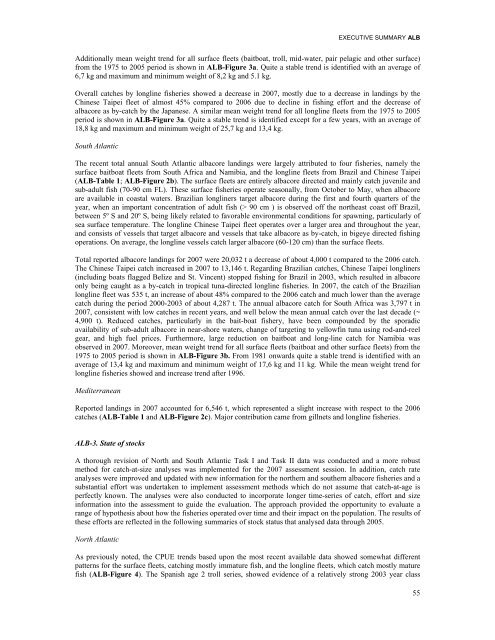REPORT OF THE STANDING COMMITTEE ON RESEARCH ... - Iccat
REPORT OF THE STANDING COMMITTEE ON RESEARCH ... - Iccat
REPORT OF THE STANDING COMMITTEE ON RESEARCH ... - Iccat
Create successful ePaper yourself
Turn your PDF publications into a flip-book with our unique Google optimized e-Paper software.
EXECUTIVE SUMMARY ALBAdditionally mean weight trend for all surface fleets (baitboat, troll, mid-water, pair pelagic and other surface)from the 1975 to 2005 period is shown in ALB-Figure 3a. Quite a stable trend is identified with an average of6,7 kg and maximum and minimum weight of 8,2 kg and 5.1 kg.Overall catches by longline fisheries showed a decrease in 2007, mostly due to a decrease in landings by theChinese Taipei fleet of almost 45% compared to 2006 due to decline in fishing effort and the decrease ofalbacore as by-catch by the Japanese. A similar mean weight trend for all longline fleets from the 1975 to 2005period is shown in ALB-Figure 3a. Quite a stable trend is identified except for a few years, with an average of18,8 kg and maximum and minimum weight of 25,7 kg and 13,4 kg.South AtlanticThe recent total annual South Atlantic albacore landings were largely attributed to four fisheries, namely thesurface baitboat fleets from South Africa and Namibia, and the longline fleets from Brazil and Chinese Taipei(ALB-Table 1; ALB-Figure 2b). The surface fleets are entirely albacore directed and mainly catch juvenile andsub-adult fish (70-90 cm FL). These surface fisheries operate seasonally, from October to May, when albacoreare available in coastal waters. Brazilian longliners target albacore during the first and fourth quarters of theyear, when an important concentration of adult fish (> 90 cm ) is observed off the northeast coast off Brazil,between 5º S and 20º S, being likely related to favorable environmental conditions for spawning, particularly ofsea surface temperature. The longline Chinese Taipei fleet operates over a larger area and throughout the year,and consists of vessels that target albacore and vessels that take albacore as by-catch, in bigeye directed fishingoperations. On average, the longline vessels catch larger albacore (60-120 cm) than the surface fleets.Total reported albacore landings for 2007 were 20,032 t a decrease of about 4,000 t compared to the 2006 catch.The Chinese Taipei catch increased in 2007 to 13,146 t. Regarding Brazilian catches, Chinese Taipei longliners(including boats flagged Belize and St. Vincent) stopped fishing for Brazil in 2003, which resulted in albacoreonly being caught as a by-catch in tropical tuna-directed longline fisheries. In 2007, the catch of the Brazilianlongline fleet was 535 t, an increase of about 48% compared to the 2006 catch and much lower than the averagecatch during the period 2000-2003 of about 4,287 t. The annual albacore catch for South Africa was 3,797 t in2007, consistent with low catches in recent years, and well below the mean annual catch over the last decade (~4,900 t). Reduced catches, particularly in the bait-boat fishery, have been compounded by the sporadicavailability of sub-adult albacore in near-shore waters, change of targeting to yellowfin tuna using rod-and-reelgear, and high fuel prices. Furthermore, large reduction on baitboat and long-line catch for Namibia wasobserved in 2007. Moreover, mean weight trend for all surface fleets (baitboat and other surface fleets) from the1975 to 2005 period is shown in ALB-Figure 3b. From 1981 onwards quite a stable trend is identified with anaverage of 13,4 kg and maximum and minimum weight of 17,6 kg and 11 kg. While the mean weight trend forlongline fisheries showed and increase trend after 1996.MediterraneanReported landings in 2007 accounted for 6,546 t, which represented a slight increase with respect to the 2006catches (ALB-Table 1 and ALB-Figure 2c). Major contribution came from gillnets and longline fisheries.ALB-3. State of stocksA thorough revision of North and South Atlantic Task I and Task II data was conducted and a more robustmethod for catch-at-size analyses was implemented for the 2007 assessment session. In addition, catch rateanalyses were improved and updated with new information for the northern and southern albacore fisheries and asubstantial effort was undertaken to implement assessment methods which do not assume that catch-at-age isperfectly known. The analyses were also conducted to incorporate longer time-series of catch, effort and sizeinformation into the assessment to guide the evaluation. The approach provided the opportunity to evaluate arange of hypothesis about how the fisheries operated over time and their impact on the population. The results ofthese efforts are reflected in the following summaries of stock status that analysed data through 2005.North AtlanticAs previously noted, the CPUE trends based upon the most recent available data showed somewhat differentpatterns for the surface fleets, catching mostly immature fish, and the longline fleets, which catch mostly maturefish (ALB-Figure 4). The Spanish age 2 troll series, showed evidence of a relatively strong 2003 year class55
















